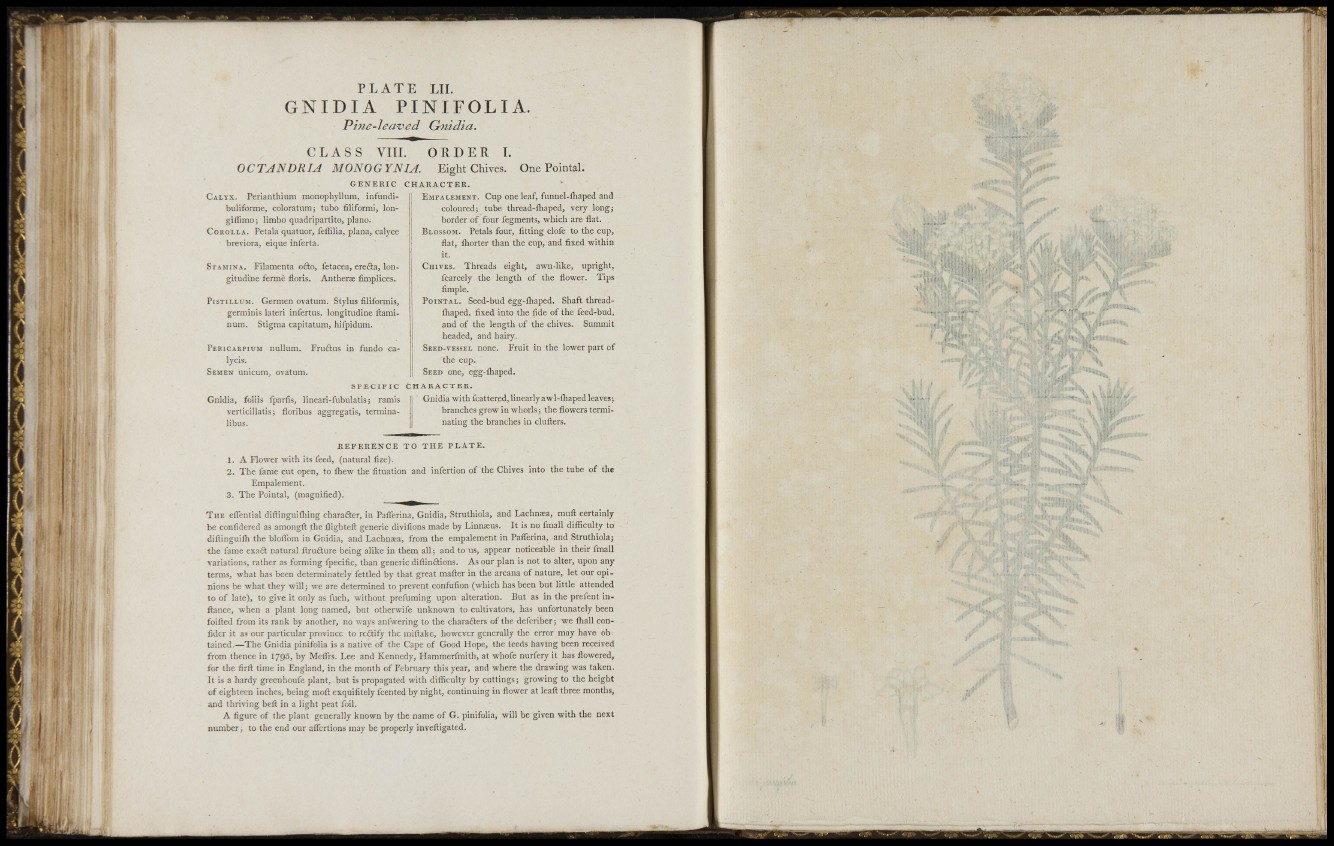
ó
.-i
Í n
P L A T E LII.
G N I D I A PINIFOLIA.
Pine-leaved Gnidia.
C L A S S VIIL ORDER L
OCTANDRIA MONOGYNIA. Eight Chives. One Pointal.
C H A R A C T E R .
EMFALEMENT. Cup one leaf, fannel-iliaped and
coloured; tube thread-ihaped, very long;
border of four fegments, which are flat.
BLOSSOM. Petals four, fitting clofe to tlie cup,
flat, fliorter than the cup, and fixed within
it.
CHIVES. Threads eight, awn-like, upright,
fcarcely the length of the flower. Tips
fimple.
P O I N T A L . Seed-bud egg-fliaped. Shaft threadfliaped,
fixed into the fide of the feed-bud,
and of the length of the chives. Summit
headed, and hairy.
SEED-VESSEL none. Fruit in the lower part of
the cup.
SEED one, egg-fliaped.
C H A R A C T E R .
Gnidia with fcattered, linearly awl-fliaped leavesj
branches grow in whorls; the flowers terminating
the branches in clufters.
G E N E R I C
CALYX. Perianthium monophyllum, infundibuliforme,
coloratum; tubo filiformi, longiífimo;
limbo quadripartito, plano.
C O R O L L A . Pétala quatuor, fefiilia, plana, calyce
breviora, eique inferta.
STAMINA. Filamenta ofto, fetacea, ereéta, longitudine
ferme floris. Antherae fimplices.
P I S T I L L U M . Germen ovatum. Stylus filiformis,
germinis lateri infertus, longitudine fliaminum.
Stigma capitatum, hiipidum.
P E R I C A K P I UM nullum. Fruñus in fundo calycis.
SEMEN unicum, ovatum.
S P E C I F I C
Gnidia, foliis fparfis, lineari-fubulatis ; ramis
verticillatis; fioribus aggregatis, terminalibus.
R E F E R E N C E TO THE PLATE.
1. A Flower with its feed, (natural fize).
2. The fame cut open, to Ihew the fituation and infertion of the Chives into the tube of the
Empalement.
3. The Pointal, (magnified).
THE eflential diftinguifhing charader, in PafiTerina, Gnidia, Struthiola, and Lachnsea, mufl: certainly
be confidered as amongft the flighteft generic divifions made by Linnaeus. It is no fmall difficulty to
diftinguiih the bloflbm in Gnidia, and Lachnaea, from the empalement in Paflerina, and Struthiola;
the fame exaa natural ftruanre being alike in them all; and to us, appear noticeable in their fmall
variations, rather as forming fpecific, than generic diflinftions. As our plan is not to alter, upon any
terms, what has been determinately fettled by that great matter in the arcana of nature, let our opinions
be what they will; we are determined to prevent confiifion (which has been but little attended
to of late), to give it only as fuch, without prefuming upon alteration. But as in the prefent inftance,
when a plant long named, but otherwife unknown to cultivators, has unfortunately been
foifted from its rank by another, no ways anfwering to the charailers of the defcriber; we fhall confider
it as our particular province to reftify the miftake, however generally the error may have obtained.—
The Gnidia pinifolia is a native of the Cape of Good Hope, the feeds having been received
from thence in 1705, by Meflrs. Lee and Kennedy, Hammerfmitli, at whofe nurfery it has flowered,
for the firft time in England, in the month of February this year, and where the drawing was taken.
It is a hardy greenhoufe plant, but is propagated with difficulty by cuttings; growing to the height
of eighteen inches, being mofi: exquifitely fcented by night, continuing in fiower at leaft three months,
and thriving beft in a light peat foil.
A figure of the plant generally known by the name of G. pinifolia, will be given with the next
number, to the end our aflTcrtions may be properly inveftigated.
a . "
: "S, ^^ 'tí. •••>> ;<>»,: AT, . 'I,
-.1
lil
ril"
J i i
m m mm